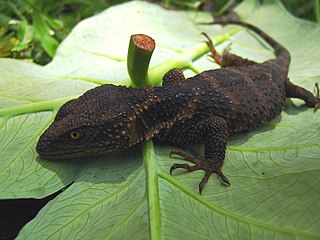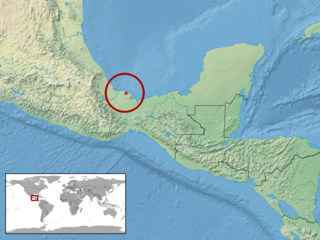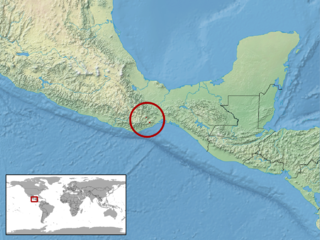
Xenosauridae is a family of anguimorph lizards whose only living representative is the genus Xenosaurus, which is native to Central America. Xenosauridae also includes the extinct genera Exostinus and Restes. Also known as knob-scaled lizards, they have rounded, bumpy scales and osteoderms. Most living species prefer humid, rocky habitats, although they are widespread within their native regions, with some inhabiting semi-arid scrub environments. They are carnivorous or insectivorous, and give birth to live young.

Xenosaurus is a genus of lizards; it is the only extant genus in the family Xenosauridae, with 14 species currently recognized. Also known as knob-scaled lizards, they can found in southwestern Tamaulipas and eastern Guerrero in Mexico. These lizards are known to feed on a variety of crawling and flying insects. This genus mostly eats orthopterans, coleopterans (beetles), dipterans, and myriapods.

Xenosaurus rectocollaris, sometimes known as the pallid knob-scaled lizard, is a species of viviparous lizard. It is endemic to Mexico where it is known from the Sierra Madre de Oaxaca of Oaxaca and Puebla states. It is a rare species occurring in rock crevices in pristine semi-arid areas.

Xenosaurus grandis, commonly known as the knob-scaled lizard, is a species of diurnal, terrestrial lizard endemic to Mexico and Guatemala. It primarily inhabits tropical rainforests. It dwells in rock crevices and eats insects.

Abronia reidi, Reid's arboreal alligator lizard, is a species of arboreal alligator lizard in the family Anguidae. The species is native to Mexico. It was described as a species new to science in 1961 by John E. Werler and Frederick A. Shannon.

Xenosaurus platyceps, the flathead knob-scaled lizard, is a lizard found in the Sierra Madre Oriental of Mexico. Its natural habitat is dry scrub forest and oak savanna. The species is endangered due to habitat fragmentation for the development of tourism and agriculture as well as predation by feral cats. Currently, the flathead knob-scaled lizard does not live in a protected area.

Shinisauria is a clade or evolutionary grouping of anguimorph lizards that includes the living Chinese crocodile lizard Shinisaurus and several of its closest extinct relatives. Shinisauria was named in 2008 by Jack Lee Conrad as a stem-based taxon to include all anguimorphs more closely related to Shinisaurus than to Anguis fragilis, Heloderma suspectum or Varanus varius. Several recent phylogenetic analyses of lizard evolutionary relationships place Shinisauria in a basal position within the clade Platynota, which also includes monitor lizards, helodermatids, and the extinct mosasaurs. Shinisaurians were once thought to be closely related to the genus Xenosaurus, but they are now considered distant relatives within Anguimorpha. The fossil record of shinisaurians extends back to the Early Cretaceous with Dalinghosaurus, which is from the Aptian aged Yixian Formation of China. Two other extinct shinisaurians are currently known: Bahndwivici from the Eocene of Wyoming and Merkurosaurus from the Late Oligocene of Germany and the Early Miocene of the Czech Republic. An indeterminate shinisaurian is known from an isolated tail found in the Eocene aged Messel pit in Germany.
Carusioidea is a clade of lizards that includes the family Xenosauridae from Central America and the extinct genus Carusia from the Late Cretaceous of Mongolia. It was named in 1998 after a sister-group relationship was found between Carusia and Xenosauridae. Phylogenetic analysis indicates that Carusioidea is the most basal clade within Anguimorpha. Features that help define Carusioidea include closely spaced orbits or eye sockets separated by fused frontal bones, a connection between the jugal and squamosal bones below the supratemporal arch, and a covering of bony osteoderms over the skull roof. Below is a cladogram showing the phylogenetic relationships of carusioids from Gao and Norell (1998):
Blutwurstia is an extinct genus of lizards from the Eocene of Wyoming. The type and only species is Blutwurstia oliviae. It is closely related to the modern lizard Xenosaurus. The genus name is derived from the German for blood sausage.
Xenosaurus agrenon, the mountain knob-scaled lizard, is a lizard found in Oaxaca of Mexico.
Xenosaurus arboreus, the arboreal knob-scaled lizard, is a lizard found in Oaxaca of Mexico.

Xenosaurus fractus is a lizard found in Mexico.
Xenosaurus manipulus is a lizard found in Mexico.

Xenosaurus mendozai is a lizard found in Mexico.
Xenosaurus newmanorum, Newman's knob-scaled lizard, is a lizard found in Mexico.

Xenosaurus phalaroanthereon, the chin-spotted knob-scaled lizard, is a lizard found in Mexico.
Xenosaurus rackhami, Rackham's knob-scaled lizard, is a lizard found in Mexico and Guatemala.
Xenosaurus tzacualtipantecus, the Zacualtipá́n knob-scaled lizard, is a lizard found in Mexico.
Xenosaurus sanmartinensis, the San Martin knob-scaled lizard, is a lizard found in Mexico.







